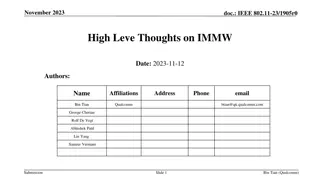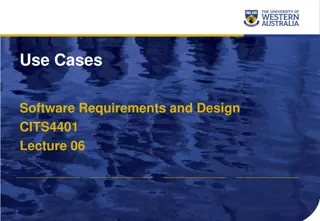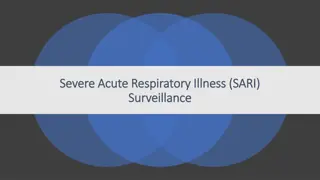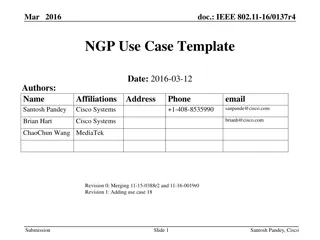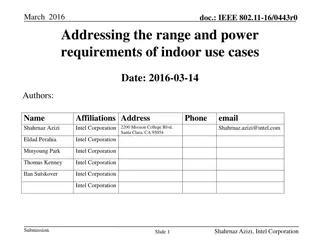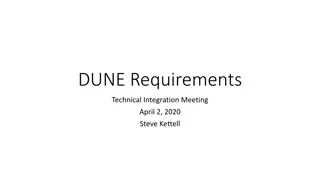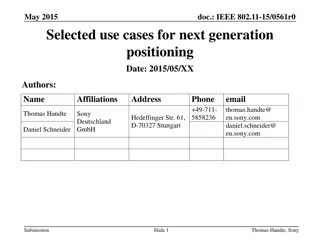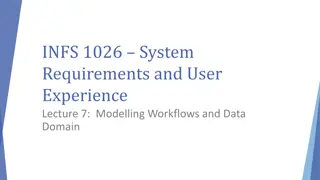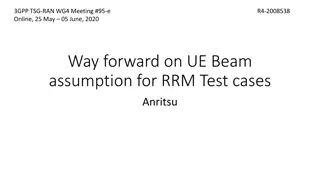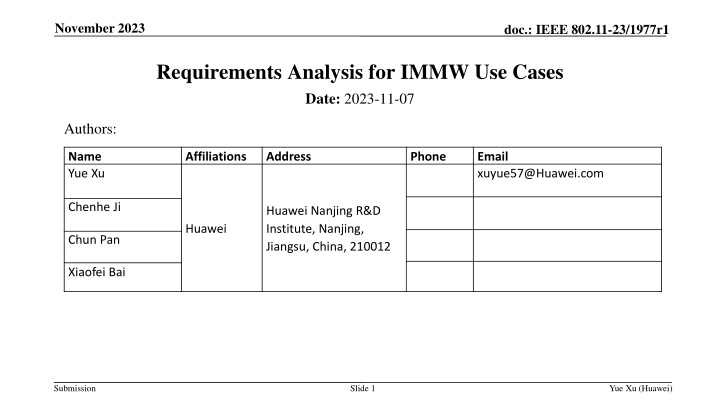
IEEE 802.11-23/1977r1: Requirements Analysis for IMMW Use Cases in November 2023
Explore the requirements and potential development directions for IMMW use cases based on the IEEE 802.11-23/1977r1 standard in November 2023. Analysis includes scenarios like industrial and residential applications, highlighting the benefits of utilizing mmWave technology for high throughput, reliability, and low latency. The study compares existing standards (e.g., 802.11ad, 802.11ay) to address the gap between technology capabilities and real-world needs, proposing enhancements and performance criteria. Witness the evolution of wireless communication for industrial environments, emphasizing high throughput, low latency, and reliability for critical operations.
Download Presentation

Please find below an Image/Link to download the presentation.
The content on the website is provided AS IS for your information and personal use only. It may not be sold, licensed, or shared on other websites without obtaining consent from the author. If you encounter any issues during the download, it is possible that the publisher has removed the file from their server.
You are allowed to download the files provided on this website for personal or commercial use, subject to the condition that they are used lawfully. All files are the property of their respective owners.
The content on the website is provided AS IS for your information and personal use only. It may not be sold, licensed, or shared on other websites without obtaining consent from the author.
E N D
Presentation Transcript
November 2023 doc.: IEEE 802.11-23/1977r1 Requirements Analysis for IMMW Use Cases Date: 2023-11-07 Authors: Name Yue Xu Affiliations Address Phone Email xuyue57@Huawei.com Chenhe Ji Huawei Nanjing R&D Institute, Nanjing, Jiangsu, China, 210012 Huawei Chun Pan Xiaofei Bai Submission Slide 1 Yue Xu (Huawei)
November 2023 doc.: IEEE 802.11-23/1977r1 Introduction Based on the 11bn PAR, this contribution analyzes the characteristics and corresponding requirements of several scenarios, like industrial, residential, etc. . By analyzing gap between the existing standards (11ad, 11ay) and actual scenario requirements, The contribution finds that IMMW SG has both prospects and further improving aspects. Finally, the contribution proposes some potential development directions and performance requirements. Submission Slide 2 Yue Xu (Huawei)
November 2023 doc.: IEEE 802.11-23/1977r1 Background Utilizing mmWave has the following advantages: - Resolve the spectrum problem of using 6 GHz band in some countries - Achieve the 11bn goals on high throughput,high reliability, and low latency Applying the concept of I (Integrated) has the following advantages: - Cost efficiency (e.g., sharing hardware parts) - Fast implementation (Reusing aspects, like some parts of sub-7G) Facilitates to deploy in industrial, and others Submission Slide 3 Yue Xu (Huawei)
November 2023 doc.: IEEE 802.11-23/1977r1 Current related standard Both 802.11ad and 802.11ay focus on the mmWave, the 11ay is one enhanced-version of 11ad (to some extent): 802.11ad support single stream communications, 7Gbps rate. 802.11ay further supports: - More coverage and higher throughput (20Gbps) - SU-MIMO, MU-MIMO, and corresponding beamforming (include hybrid) Use Case [1] Range Throughput Delay (ms) Reliability Ultra Short Range Communication < 10 cm 10 Gbps <100 4k/8k UHD Transmission < 5 m < 28 Gbps 10~20 jitter<5ms VR < 10 m ~20 Gbps 5~10 jitter <5 ms, PER<10E-2 Data Center < 1.5 m ~40 Gbps <100 >99.99% Mobile Offloading & Multiband Operation < 100 m ~20 Gbps <100 >99.99% Mobile Fronthauling < 200 m ~20 Gbps >99.99% Nowadays, especially industrial scenarios, higher throughput, lower latency, and more reliable wireless communication are required. Therefore, it is necessary to analyze the real needs and find the way out Submission Slide 4 Yue Xu (Huawei)
November 2023 doc.: IEEE 802.11-23/1977r1 Case 1: 4K UHD Wireless Transfer at Industrial Environment Example: Wireless HD cameras quickly determine whether products on the line are defective, incomplete, etc. One or more devices can save costs by uploading data to the cloud for analysis and feedback instructions (e.g., compared to distributed AI process hardware) . Regardless of the time it takes for the image processing, sensing devices such as HD cameras require high throughput, low latency, and high reliability. Involving communication, including guidance control, process data exchange, video/image, and emergency stop, between robots and a control system, AMR (Autonomous Mobile Robot) Periodical report of informationto the control system. High- density deployment environment. Sensors Robot/drone motion control Remote operation with haptics communication, programmed robot operation with emergency stop. High-definition video transferring from cameras. Video transfer E.g., One 4K UHD streams (60 frame/s, 24 bits/pixel, minimum 4:2:2 chroma sampling) require at least 15 Gbps data rate. And 8K need at least 28 Gbps. And such a throughput requirement, also happens to be the advantage of IMMW. Walk-by health monitoring, combining video feed with overlaid contextual information. AR/VR/XR Requirements: - Throughput ~ high - Latency < 100ms - Packet Error Rate < 1e-7 - Jitter < 5ms - delay < 5ms. - Reliability > 99.99% HD camera Combination of AMR, sensors, robot/drone motion control, and video transfer. Assembly line - - Use case Latency Reliability - AMR < 100ms 99.99% - RFID < 100ms 99.99% - PLC to MES < 100ms 99.99% Noted: PLC to IO 8ms 99.999% Reliability in industrial scenarios is determined by multiple dimensions: Response Latency, Roaming Latency, Roaming Successful Rate, consecutive packets lost rate, and others. 1. Mainly consider target use cases. (e.g., fixed equipment in industrial scenarios, such as distributed robotic arms). 2. Submission Slide 5 Yue Xu (Huawei)
November 2023 doc.: IEEE 802.11-23/1977r1 Case 2: AR and VR Virtual reality technology not only provides better entertainments, but also facilitates people's health, such as telemedicine. Whether recreational or medical, the real needs can be summarized as follows [4]: Monocular Video Resolution Lightly Compressed Rate (Gbps) Bits per Pixel Frame Rate Compressed Rate (Gbps) RTT Latency Raw Rate (Gbps) Requirements: - Throughput ~ high - Latency 5~10ms - Packet Error Rate < 1e-7 - Jitter < 10ms 2D, 40.83/ 20.42 2D, 4.83/ 2.04 2D, 0.48/ 0.20 Partial Immersion 6300*3000 12 60 10ms 3D, 81.66/ 40.84 3D, 9.66/4.04 3D, 0.97/0.40 - 2D, - 2D, 23.6/ 11.8 2D, 2.36/1.18 236.20/118.10 Deep Immersion 16200*4500 12 90 5ms - 3D, 3D, 47.2/23.6 3D, 4.72/2.36 472.40/236.20 2D, 2D, 80.62/ 40.31 2D, 8.06/4.03 806.22/403.11 Ultimate Immersion 21600*7200 12 144 5ms 3D, 3D, 161.24/80.62 3D, 16.12/8.03 1612.44/806.22 Submission Slide 6 Yue Xu (Huawei)
November 2023 doc.: IEEE 802.11-23/1977r1 Potential development direction Here, we're more about the potential direction from the high level. For example, the following technologies can be considered based on requirements: Hardware Friendly (baseband shared) SU-MIMO Higher Data Rate Support Large Bandwidth Support Spectral Efficiency Enhancement BF Training Enhancement Reliability Support CFO Mitigation MAC Enhancement Latency Support QoS (Quality-of-Service) Support Others Submission Slide 7 Yue Xu (Huawei)
November 2023 doc.: IEEE 802.11-23/1977r1 Summary IMMW is friendly to implement in different scenarios, e.g., industrial, medical, residential and others, as it is an efficient way to improve throughput, latency, and reliability performance and reduce costs. However, there is still some room for further thought and improvement. Submission Slide 8 Yue Xu (Huawei)
November 2023 doc.: IEEE 802.11-23/1977r1 References [1] 11-15-0328-04-ng60-ng-60-usage-models [2] 11-23-0066-01-0uhr-thoughts-on-utiliizing-mmwave [3] 11-22-1872-00-0uhr-considerations-on-phy-designs-for-mmwave-band [4] 11-18-0846-02-0wng-next-generation-phy-mac-in-sub-7ghz Submission Slide 9 Yue Xu (Huawei)



